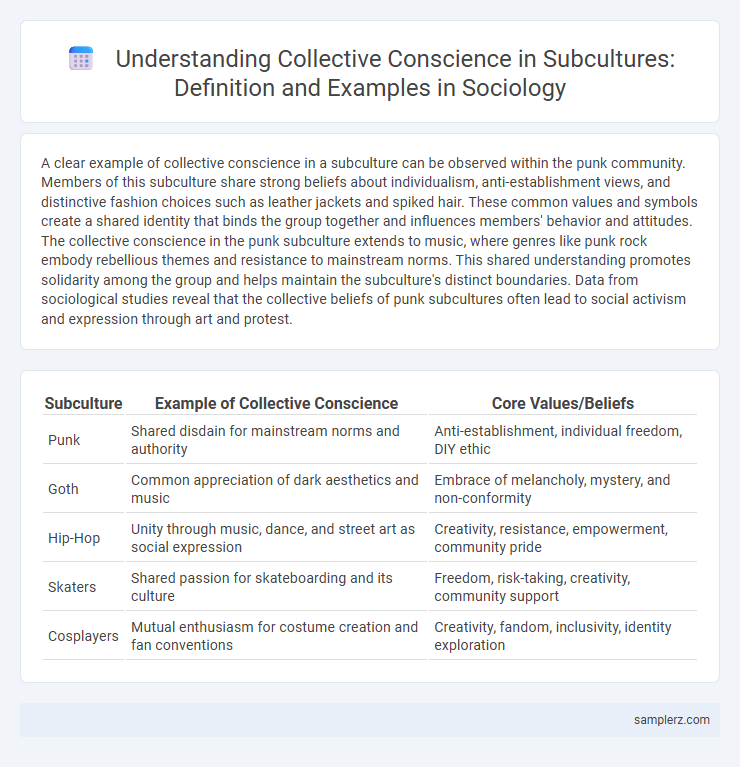A clear example of collective conscience in a subculture can be observed within the punk community. Members of this subculture share strong beliefs about individualism, anti-establishment views, and distinctive fashion choices such as leather jackets and spiked hair. These common values and symbols create a shared identity that binds the group together and influences members' behavior and attitudes. The collective conscience in the punk subculture extends to music, where genres like punk rock embody rebellious themes and resistance to mainstream norms. This shared understanding promotes solidarity among the group and helps maintain the subculture's distinct boundaries. Data from sociological studies reveal that the collective beliefs of punk subcultures often lead to social activism and expression through art and protest.
Table of Comparison
| Subculture | Example of Collective Conscience | Core Values/Beliefs |
|---|---|---|
| Punk | Shared disdain for mainstream norms and authority | Anti-establishment, individual freedom, DIY ethic |
| Goth | Common appreciation of dark aesthetics and music | Embrace of melancholy, mystery, and non-conformity |
| Hip-Hop | Unity through music, dance, and street art as social expression | Creativity, resistance, empowerment, community pride |
| Skaters | Shared passion for skateboarding and its culture | Freedom, risk-taking, creativity, community support |
| Cosplayers | Mutual enthusiasm for costume creation and fan conventions | Creativity, fandom, inclusivity, identity exploration |
Understanding Collective Conscience in Social Subcultures
The collective conscience in social subcultures manifests through shared values, beliefs, and rituals that distinguish members from mainstream society, fostering a strong group identity and social cohesion. These subcultures often develop unique symbols, language, and norms that both express and reinforce their collective conscience, such as the punk movement's emphasis on anti-establishment ideals and distinctive fashion. Understanding these dynamics provides insight into how social subcultures maintain internal solidarity while influencing broader cultural landscapes.
How Collective Conscience Shapes Subcultural Identity
Collective conscience in subcultures manifests through shared beliefs, values, and practices that create a distinct group identity separate from mainstream society. This common understanding reinforces solidarity and belonging among members, shaping norms, rituals, and symbols unique to the subculture. The strength of this collective conscience influences how subcultural identity resists dominant cultural influences and fosters cohesion within the group.
Punk Rock: A Case Study in Group Morality
Punk Rock exemplifies collective conscience through its shared values of anti-establishment views, DIY ethics, and nonconformity, which unify members into a distinct social group. The subculture's moral code emphasizes resistance to mainstream norms, fostering solidarity and identity among its participants. This collective morality shapes behaviors, symbolism, and social interactions within Punk Rock communities, reinforcing group cohesion.
Skateboarding Communities and Shared Social Values
Skateboarding communities exemplify collective conscience through shared social values such as creativity, freedom, and resistance to mainstream norms. These subcultures foster a strong sense of identity and belonging, where communal rituals like group skating sessions and local competitions reinforce mutual respect and solidarity. The collective conscience manifests in unwritten codes of conduct, including respect for public spaces and support among members, sustaining the subculture's cohesion and resilience.
The Role of Collective Beliefs in Hip-Hop Culture
Hip-hop culture exemplifies collective conscience through shared beliefs in resistance, identity, and social justice, which unify its community. Elements like graffiti, rap, and breakdancing serve as expressive outlets reinforcing these collective values. These art forms create a cohesive subcultural identity that challenges dominant societal narratives and fosters solidarity among marginalized groups.
Cosplay Fandoms: Building Unity Through Shared Norms
Cosplay fandoms exemplify collective conscience by fostering unity through shared norms of creativity, respect, and collaboration. Members adhere to unwritten codes, such as mutual support in costume craftsmanship and positive interaction during conventions. This common value system strengthens group identity and maintains social cohesion within the subculture.
Collective Conscience Among Online Gaming Clans
Collective conscience among online gaming clans is exemplified by shared values, norms, and goals that bind members into a cohesive social group. These clans develop unique ethical codes and communication styles that distinguish them from broader gaming communities while fostering cooperation and loyalty. This collective identity sustains group cohesion, reinforces social order, and motivates coordinated actions in competitive and social gaming environments.
LGBTQ+ Subculture: Solidarity and Group Ethics
The LGBTQ+ subculture exemplifies collective conscience through shared values of acceptance, inclusivity, and resistance against discrimination, which foster a strong sense of solidarity among its members. Group ethics in this subculture emphasize mutual support, advocacy for equal rights, and preservation of diverse identities, reinforcing a unified social identity. Events like Pride parades and community centers serve as tangible expressions of this collective moral framework and social cohesion.
Street Art Movements: Unspoken Social Contracts
Street art movements embody a collective conscience through unspoken social contracts that guide artists' respect for public spaces and community values. These norms foster collaboration among diverse creators while challenging mainstream narratives and authority. Street art's unwritten rules reinforce identity, solidarity, and cultural expression within urban subcultures.
Peer Influence and Group Morality in School Cliques
School cliques demonstrate collective conscience through shared peer influence, where group norms dictate acceptable behavior, reinforcing social cohesion and conformity among members. Group morality within these cliques establishes unwritten rules that regulate actions, promoting loyalty and mutual support while marginalizing dissenters. This collective moral framework shapes individual identities and maintains group solidarity within the subculture of adolescent social groups.

example of collective conscience in subculture Infographic
 samplerz.com
samplerz.com